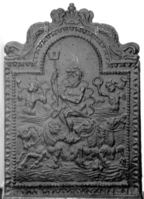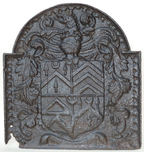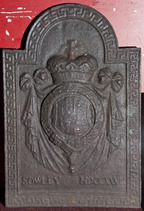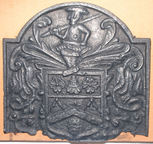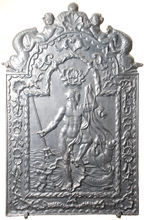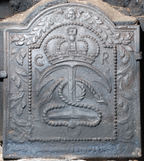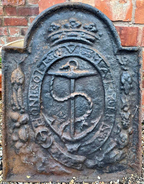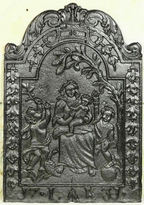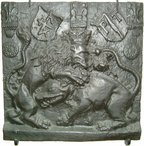-
110
Description: Arched rectangular shaped central panel with fillet and bead edging, Neptune/Poseidon, holding a trident in his right hand, sitting in a scallop shell drawn by four mythical sea horses, behind are two mermaids; arched rectangular shaped border with ovolo egg and dart edging; above, two symmetrical dolphins with a clam shell between.
Notes: Typical type of firebacks produced in Germany for the Dutch market; the central panel was made separately for insertion into different borders; this border is a relatively simple type. Formerly part of the Ade Collection (from Grove Hill, Hellingly, Sussex).
Copies of this fireback are known.
- Decoration tags:
- 'Dutch' (shape)
- ovolo, egg and dart (edging)
- carved pattern panels
- mythological
- animals
- humans
Manufactured: in the mid- to late-17th century possibly in the Siegerland area of Germany.
Current location: Hastings Museum and Art Gallery, John's Place, Bohemia Road, Hastings, East Sussex, England.
Museum number: HASMG: 1952.51.36 (part of the Hastings Museum museum group)
Citation: Lloyd, N., 1925, 'Domestic Ironwork I', Architectural Review, 58, pp. 58-67.
- Attached to series:
- 'Dutch' Miscellaneous Firebacks
- 'Dutch' Dolphin series
-
915
Description: Rectangular with superimposed arch; embattled, cavetto-moulded edging, with the top edge of the rectangle interrupted; quartered shield, helm, crest and mantling.
Notes: The arms appear to be those of the family of Armeston of Burbage, Leicestershire, possibly Thomas Armeston (c1606-85), 2nd son of Thomas Armeston (d.1640), sometime MP for Leicestershire: 1st and 4th (Armeston) sable a chevron between three spear heads argent with a crescent for difference, 2nd (unknown) three chevronels with a rose in a canton, 3rd (unknown) a fess between two chevronels, a crescent for difference over all. The Armeston crest is a dragon's head erased vert scaled or and charged with a crescent of the same for difference; the crescent is the mark of cadency for the second son; in this instance the arms appear to be of a second son descended from a second son in an earlier generation. The embattled edging and superimposed arch are features of a series of firebacks dated 1619. However, the style of the mantling is typical of a small group of firebacks noted in Herefordshire.
Arms: Armeston, of Burbage, Leicestershire
- Decoration tags:
- rectangular with round arch (shape)
- embattled cavetto (edging)
- whole carved pattern
- armorial
Manufactured: in the early- to mid-17th century in England.
Current location: in private hands, Honiton, Devon, England.
- Attached to series:
- Personal armorial firebacks
- Herefordshire armorial series
-
1108
Description: Arched rectangular shape; Greek Key border with fillet edges; in high relief, in front of swagged drapery, the shield of, quarterly, France quartering England, Scotland and Ireland, surrounded by a Garter, and surmounted by a ducal coronet; below, the inscription in capitals.
Notes: The use of the Greek Key design as a border is believed to be unique for an English fireback. Although somewhat indistinct, the use of the Stuart royal arms and the ducal coronet can be explained by the fact that the fireback was one of a group cast for the 2nd Duke of Richmond, whose father, the 1st duke, was the illegitimate son of Charles II and Louise de Kéroualle. The Richmond arms were differenced from the Stuart royal arms by the addition of a bordure compony (the detail of which is not distinct on this casting). Sowley Furnace, near Beaulieu in Hampshire, was owned in 1732 by John, 2nd Duke of Montagu, and was let to Miles Troughton. Similar, but larger, variants of this fireback are at Goodwood House, the seat of the Dukes of Richmond, where this fireback is likely to have once been. Criterion Auctions, Islington, 7 Jan 2019, lot 128 (£50).
Inscription: HONI SOIT QUI MAL Y PENSE / SOWLEY MDCCXXXII
Arms: Duke of Richmond
- Decoration tags:
- rectangular with round arch (shape)
- fillet (edging)
- carved pattern panels
- heraldic
- armorial
- royal
- text
Manufactured: in 1732 at Sowley Furnace, Beaulieu in the New Forest area of England.
Current location: not known.
-
376
Description: Arched rectangular shape; fillet edge on top and sides. Shield, helm, crest and mantling of the Worshipful Company of Joiners and Ceilers.
Notes: Blazon: Gules a Chevron Argent between in chief two pairs of Compasses extended at the points and in base a sphere Or. On a chief of the second a pale Azure between two Roses of the field barbed and seeded proper, the pale charged with an Escallop of the second; Crest: a demi Savage proper wreathed about the head and waist with Leaves Vert holding in the dexter hand over the shoulder a Tilting Spear Or headed Argent; arms granted 1571.
Copies of this fireback are known.
Arms: Worshipful Company of Joiners and Ceilers
- Decoration tags:
- rectangular with round arch (shape)
- fillet (edging)
- whole carved pattern
- armorial
Manufactured: in the mid-17th century possibly in the Weald area of England.
Current location: Anne of Cleves House, Southover High Street, Lewes, East Sussex, England.
Museum number: LH000.938 (part of the Sussex Archaeological Society museum group)
- Attached to series:
- Livery company firebacks
-
555
Description: Arched rectangular central panel with overlapping leaf edging; pictorial scene of Poseidon/Neptune holding a trident in this right hand, and grasping the reins of two hippocampi in his left hand; beneath his feet a scallop shell, and to his lower left a putto blowing a horn; suspended above him an assemblage of shells; stepped-arched rectangular shaped border with scalloped fillet edging; top centre, scallop shell with a descending arrangment of seashells and seaweed; on top, a scallop shell between two putti and below them, two dolphins.
Notes: An uncharacteristically elaborate version of the usual 'Dutch' style of fireback, suggesting a later date, or possibly a pastiche. Mitford collection, Petworth House.
- Decoration tags:
- 'Dutch' (shape)
- scalloped fillet (edging)
- whole carved pattern
- pictorial
- mythological
- humans
Manufactured: in the mid- to late-18th century in Germany.
Current location: Petworth House, Petworth, West Sussex, England.
Museum number: NT/PET/M/47 (part of the National Trust museum group)
- Attached to series:
- 'Dutch' Miscellaneous Firebacks
-
684
Description: Arched rectangular central panel with bead edging; an inverted, cabled anchor surmounted by a crown, flanked by one initial each side; arched rectangular border with cavetto-moulded edging; top centre, face of a putto with flowing leaf arrangement descending each side.
Notes: An English pastiche of the ‘Dutch’ style of fireback, which became popular in the second half of the seventeenth century. One of a small series of firebacks with similar proportions and detail. Much copied.
Copies of this fireback are known.
Inscription: C R
- Decoration tags:
- rectangular with round arch (shape)
- cavetto (edging)
- whole carved pattern
- planklines
- heraldic
- text
- objects
Manufactured: in the mid- to late-17th century in England.
Current location: in private hands, Sevenoaks, Kent, England.
- Attached to series:
- Carolean 'Dutch' series
- Miscellaneous royal firebacks
-
1087
Description: Arched rectangular shape; cavetto-moulded edging; central fouled anchor within a Garter surmounted by a ducal coronet; fructal swags to each side.
Notes: The anchor may relate to the office of Lord High Admiral who, in the third quarter of the 17th century was James, Duke of York (afterwards King James II). Another example was sold at Christie's auction 12 Oct 2010 lot 109 (£500). A variant with a viscount's coronet is at Chastleton House, Oxfordshire.
Copies of this fireback are known.
Inscription: HONI SOIT QUI MAL Y PENSE
- Decoration tags:
- rectangular with round arch (shape)
- cavetto (edging)
- whole carved pattern
- heraldic
- text
- objects
Manufactured: in the mid- to late-17th century in England.
Current location: Stratford upon Avon, Warwickshire, England.
- Attached to series:
- Miscellaneous royal firebacks
-
1017
Description: Arched rectangular central panel with fillet edging; central seated female with an infant in her arms, a swan at her feet and a standing child on each side, the one to her left facing the front and holding aloft a flaming heart, its foot on a ball; the child to her right facing the woman, holding aloft a branch in its left hand, all on a ground with an overhanging tree to the right; arched rectangular border with fillet edging with descending festoons of acanthus flowers on each side, the date and initials at the bottom and, at the top on each side, a pair of acanthus flowers descending from a heart-shaped terminal of a strapwork frame; above, mirrored swirls of foliage.
Notes: The central pictorial scene is a crude pastiche of a panel portraying an allegory of Charity frequently used on firebacks produced in the Siegerland of north-west Germany for the Dutch market in the second half of the seventeenth century. The swirled foliage on the top is typical of English 'Dutch' style firebacks of the early-eighteenth century and the numerals are also more typically English in style.
Inscription: 17 . IAK[?] 31
- Decoration tags:
- 'Dutch' (shape)
- fillet (edging)
- whole carved pattern
- individual letters
- individual numbers
- allegorical
- text
- humans
- plants
Manufactured: in 1731 in England.
Current location: not known.
- Attached to series:
- Charity firebacks
- British 'Dutch' style firebacks
-
739
Description: Rectangular; a crowned lion fighting a boar in high relief on a raised bottom panel; above, a stamp formed from a fleur-de-lys on a bracket repeated three times, centre left and right corners; two angled shields and two sunburst discs.
Notes: The shields probably signify civic or personal allegiance; the symbolism of the fighting beasts is not known. Part of the bequest to the Victoria and Albert Museum by Lieut. Colonel G. B. Croft-Lyons in 1926.
Inscription: P T
- Decoration tags:
- rectangular (shape)
- none (edging)
- whole carved pattern
- heraldic
- armorial
- text
- animals
Manufactured: in the late-16th to early-17th century in Germany.
Current location: Victoria & Albert Museum, Cromwell Road, Kensington & Chelsea, Greater London, England.
Museum number: M.576-1926 (part of the Victoria & Albert Museum museum group)
- Attached to series:
- Foreign armorial firebacks
-
754
Description: Rectangular; flanged edging; two panels at top, each with double astragal edging, containing the figures of St James and St Peter; plain panel below with same dging; bottom panel with fillet edging containing carved stamps of scrolled foliage and beasts.
Notes: Carved religious figures are common on stove-plates.
- Decoration tags:
- rectangular (shape)
- flanged (edging)
- carved stamps
- biblical
- humans
Manufactured: in the mid- to late-16th century possibly in the Eifel area of Germany.
Current location: Victoria & Albert Museum, Cromwell Road, Kensington & Chelsea, Greater London, England.
Museum number: M.334-1940 (part of the Victoria & Albert Museum museum group)
- Attached to series:
- Stoveplates
